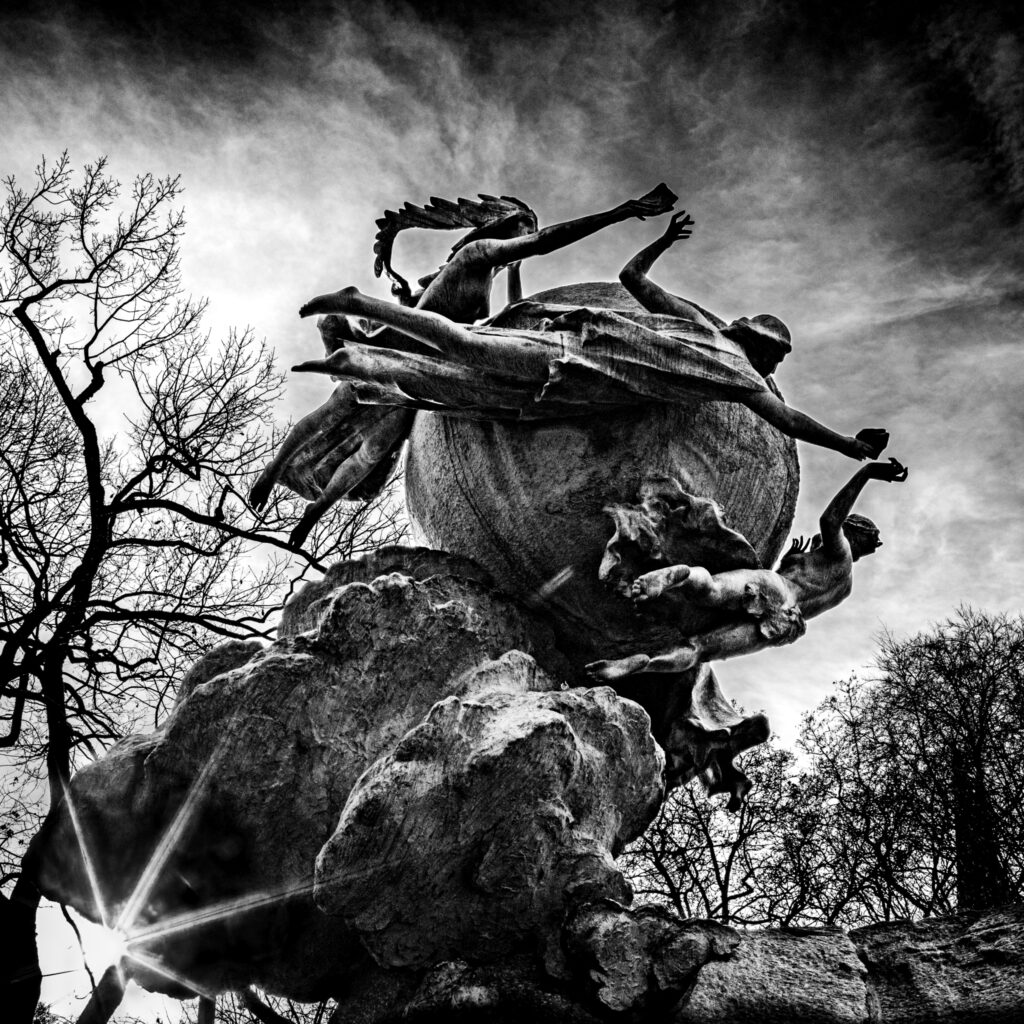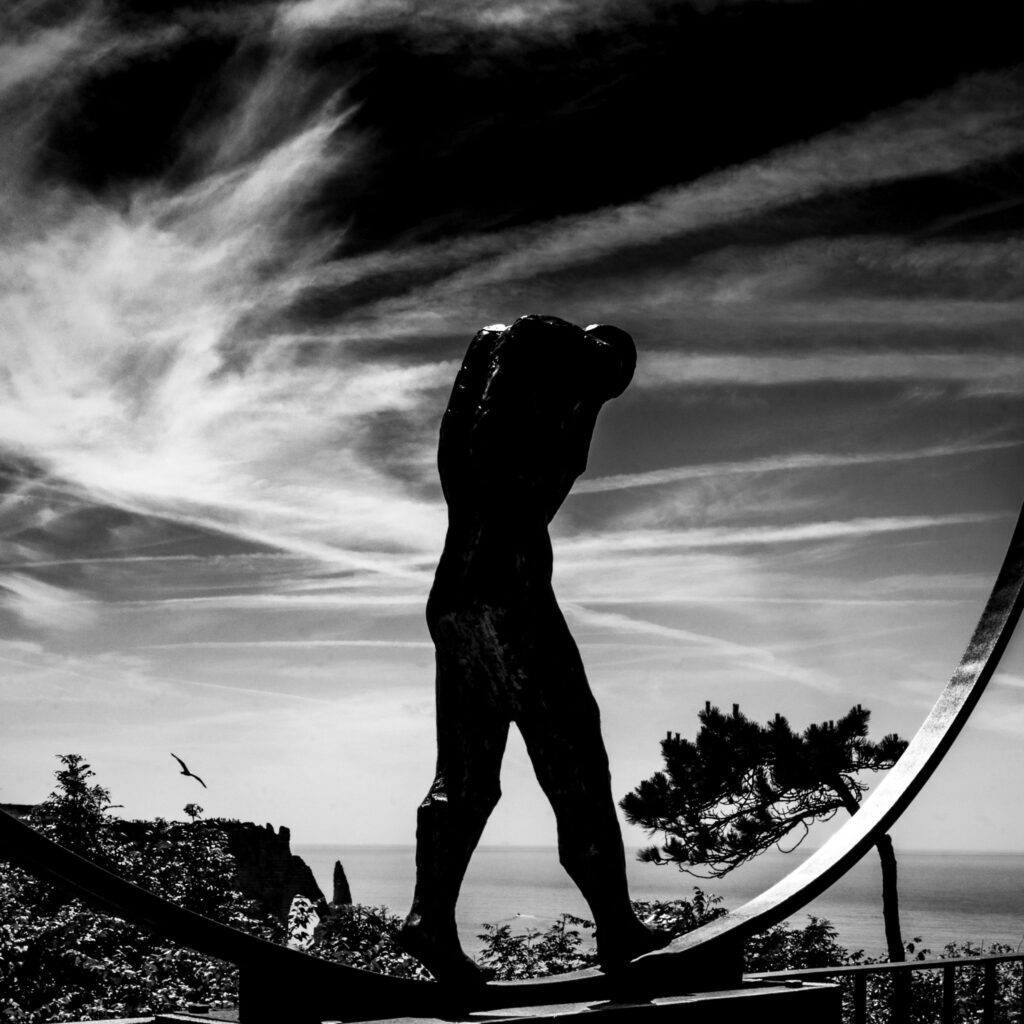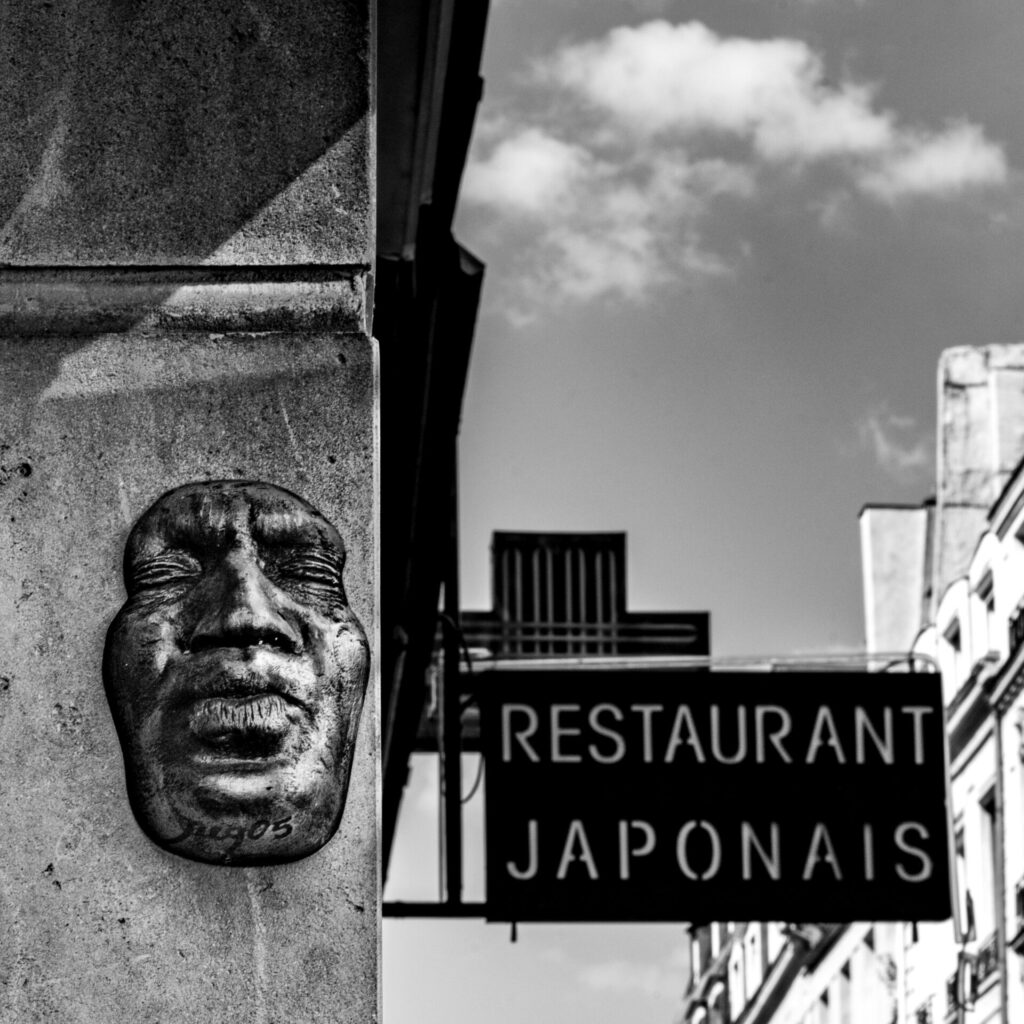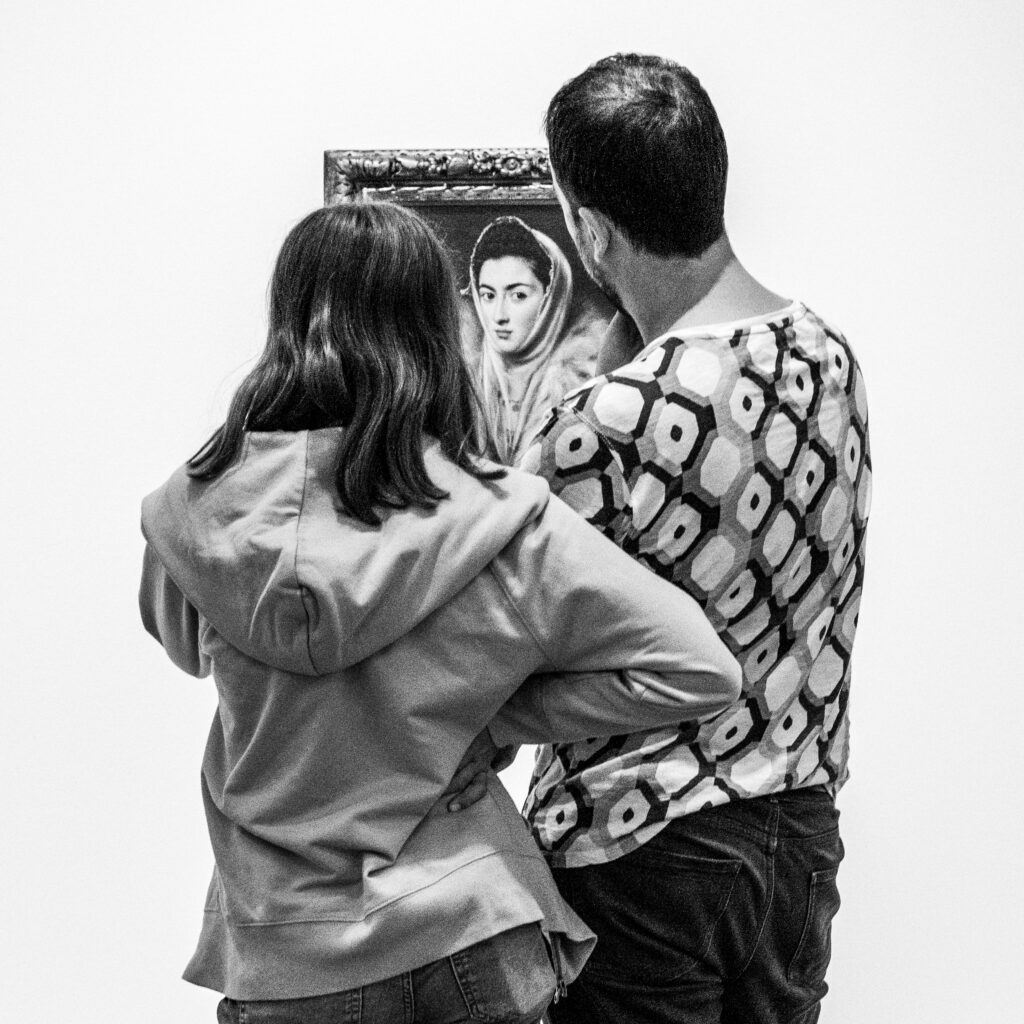DEUTSCHE FASSUNG NACH DER ENGLISCHEN VERSION
I have an ambivalent feeling about photographing artworks, as I don’t want to adorn myself with other people’s feathers. Today I would like to present a few such images, in which I see a creative achievement of my own.

Hasselblad CFV II 50C/907X XCD 30 F 22 1/250 sec 400 ASA, Handing Letters around the World.
One of my hobbies is collecting stamps from all over the world between 1840 and 1960. International cooperation between postal administrations is organized by the Universal Postal Union, which was founded in 1874 in Bern (Switzerland). This is also where the Universal Postal Monument, created by René de Saint-Marceaux, stands since 1909, depicting five female messengers hovering around the globe and passing letters to each other. The motif has since been depicted on several hundred stamps worldwide, such as the last stamps of the Principality of Bahawalpur in 1949, which subsequently became part of Pakistan.
The photographic challenge was to find the right angle so that the messengers stood out well against the background, the sun created a nice star, the trees and sky provided a dramatic context and there were no other people or objects in the picture. Post-processing was essentially adjusting the brightness, such as brightening the monument and reducing the haze in the sky.

Hasselblad CFV II 50C/907X XCD 30 F 8 1/125 sec 3200 ASA, Studying the catalogue
The Kunstmuseum Bern has accepted the estate of Cornelius Gurlitt, whose father was a prominent art dealer in Germany during the Nazi regime. The exhibition catalogue deals in detail with the themes of “degenerate art” and “looted art”, which seem to interest this gentleman.
In summer 2022, we took a road trip to the north of France. East of Le Havre lies the garden of Étretat, which is beautifully designed with plants and artwork and great views of the sea and the chalk cliffs.

“Walking in circles” Hasselblad CFV II 50C/907X, XCD 30, F 32 1/125 sec, ISO 400
I particularly liked the larger-than-life heads of the Spanish artist Samuel Salcedo (https://3punts.com/en/artist/samuel-salcedo). However, capturing them photographically proved to be a challenge in several respects: partly they were in the shade, partly the surroundings were not nice looking, partly I would have had to hover three metres above the ground for a good perspective.
Finally, I discovered three heads, which were close enough to fit into one picture and nicely embedded in plants. The problem, however, was that two footpaths run between them and visitors were constantly walking through the picture. To make matters worse, an Italian Instagram influencer had chosen the same motif for her video. At first, she threw me amiable eyeballs. But this soon turned into frosty glances as I stoically remained for ten minutes on the spot with the best perspective that she had actually chosen for herself: if glances could kill, I probably wouldn’t be here anymore. In view of these external adversities, I am quite satisfied with the calmness the picture exudes.

“Three Smiles” Hasselblad CFV II 50C/907X, XCD 30, F 11 1/125 sec, ISO 400
With public art, I try to capture the interaction of the work with its surroundings. In the image below, I liked the way the silver rider was embedded in the city environment as an “urban cowboy” (Charles Ray “Horse and Rider”, Pinault Collection Bourse de Commerce Paris).

“Silver Rider” Hasselblad CFV II 50C/907X, XCD 65, F 29 1/125 sec, ISO 400
I captured the wall art of an unknown artist on the wall of a house in Paris in such a way that it could well be the portrait of the doorman of the restaurant behind, who refuses entry to guests without a reservation.

“Restaurant japonais” Hasselblad CFV II 50C/907X, XCD 65, F 20 1/125 sec, ISO 400
In the next image I liked the interplay of the artwork with the elements: the raindrops in the foreground respectively the blades of the central shutter in the light reflections in the background (Auguste Rodin “Kiss” Beyeler Museum, Basel):

“Rodin’s Kiss in the Rain with Central Shutter Sunbeams” Hasselblad CM 501, Sonnar 150, ISO 400.
In the next image, the clouds seem to map the structure of the sculpture’s back:

“Tired worker” Hasselblad CFV II 50C/907X, XCD 65, F 32 1/125 sec, ISO 400
Creativity sometimes excuses lame wordplays, like when you put an extra star on a star like Freddie Mercury 😉

“Freddie’s star shines forever”, Hasselblad CFV II 50C/907X, XCD 30, F 6.8 1/2000 sec, ISO 400
In indoor spaces such as museums, I try to capture the interaction of visitors with the artworks. This occasionally reflects a devotional attitude (Kunstmuseum Basel):

“Devotional worship”, Hasselblad CM 501, Distagon 50, ISO 400.
Now and then the body language tends to express scepticism (Picasso-Greco exhibition at Kunstmuseum Basel):

“Hat and Horseman”, Hasselblad CFV II 50C/907X, XCD 30, F 5, 1/125 sec, ISO 3200.
Other visitors can’t get close enough to the picture (Andy Warhol at the Kunstmuseum Basel)

“Watching Warhol”, Hasselblad CFV II 50C/907X, XCD 30, F 3.5, 1/125 sec, ISO 3200
Sometimes the work of art seems to look at the visitor and vie for her attention (Edvard Munch in the Kunstmuseum Basel)

“Two Ladies Watching”, Hasselblad CFV II 50C/907X, XCD 30, F 3.5, 1/125 sec, ISO 3200
Sometimes one wonders who is watching whom? (Picasso – Greco exhibition at the Kunstmuseum Basel)

“who is watching whom”, Hasselblad CFV II 50C/907X, XCD 30, F 4.8, 1/125 sec, ISO 3200
Other pictures seem to roll their eyes slightly annoyed by the constant photographing with the mobile phone: (Picasso – Greco exhibition in the Kunstmuseum Basel)

“eye to eye with Picasso”, Hasselblad CFV II 50C/907X, XCD 30, F 4, 1/125 sec, ISO 1600
Last but not least, friends of repeating patterns usually find exciting motifs in the souvenir shop:

“Nofretete”, Hasselblad CFV II 50C/907X, XCD 65, F 2.8, 1/125 sec, ISO 1600
Geschichten hinter Bildern mit Kunstwerken
Ich habe ein ambivalentes Gefühl zum Fotografieren von Kunstwerken, da ich mich nicht mit fremden Federn schmücken will. Heute möchte ich ein paar solche Bilder vorstellen, in welchen ich eine eigene kreative Leistung sehe.

Hasselblad CFV II 50C/907X XCD 30 F 22 1/250 sec 400 ASA, Handing Letters around the World
Eines meiner Hobbies ist das Sammeln von Briefmarken aus der ganzen Welt zwischen 1840 und 1960. Die internationale Zusammenarbeit zwischen den Postverwaltungen wird durch den Weltpostverein geregelt, welcher 1874 in Bern (Schweiz) gegründet wurde. Dort steht auch seit 1909 das von René de Saint-Marceaux geschaffene Weltpostdenkmal, auf dem fünf Botinnen die Erdkugel umschweben und sich Briefe weitergeben. Das Motiv wurde seither auf mehreren hundert Briefmarken weltweit abgebildet, wie etwa 1949 auf den letzten Marken des Fürstentums Bahawalpur, welches anschliessend Teil Pakistans wurde.
Die fotografische Herausforderung war das Finden des passenden Standorts, so dass sich die Botinnen gut vom Hintergrund abhebten, die Sonne einen schönen Stern schuf, die Bäume und der Himmel einen dramatischen Kontext bildeten und keine sonstigen Personen oder Gegenstände auf dem Bild waren. Die Nachbearbeitung bestand im Wesentlichen in der Justierung der Helligkeit, wie etwa dem Aufhellen des Denkmals und der Reduzierung des Dunsts im Himmel.

Hasselblad CFV II 50C/907X XCD 30 F 8 1/125 sec 3200 ASA, Studying the catalogue
Das Kunstmuseum Bern hat den Nachlass von Cornelius Gurlitt angenommen, dessen Vater während der Herrschaft der Nationalsozialisten ein prominenter Kunsthändler in Deutschland war. Der Ausstellungskatalog setzt sich detailliert mit den Themen „entartete Kunst“ und „Raubkunst“ auseinander, welche diesen Herrn zu interessieren scheinen.
Im Sommer 2022 unternahmen wir einen Road Trip in den Norden Frankreichs. Östlich von Le Havre befindet sich der Garten von Étretat. Dieser ist wundervoll mit Pflanzen und Kunstwerken gestaltet und bietet einen Blick auf Meer und Kreidefelsen.

„Walking in circles“ Hasselblad CFV II 50C/907X, XCD 30, F 32 1/125 sec, ISO 400
Besonders gut gefielen mir die überlebensgrossen Köpfe des spanischen Künstlers Samuel Salcedo (https://3punts.com/en/artist/samuel-salcedo). Diese fotografisch festzuhalten erwies sich jedoch als Herausforderung in mehrfacher Hinsicht: teils lagen sie im Schatten, teils war die Umgebung nicht besonders, teils hätte ich für eine gute Perspektive drei Meter über dem Boden schweben müssen.
Schliesslich entdeckte ich drei Köpfe, die so nahe zusammen lagen, dass sie auf ein Bild passten und schön in Pflanzen eingebettet waren. Das Problem war jedoch, dass dazwischen zwei Fusswege hin durch führten und stetig Besucher durchs Bild liefen. Erschwerend kam dann hinzu, dass sich eine italienische Instagram Influencerin das gleiche Motiv für ihr Video ausgesucht hatte. Zunächst warf sie mir noch liebenswürdiges Augenklimpern zu. Dies ging jedoch bald in frostigere Blicke über, weil ich stoisch während zehn Minuten auf dem Platz mit der besten Perspektive verharrte, den sie eigentlich für sich ausgesucht hatte: wenn Blicke töten könnten, wäre ich wohl nicht mehr hier. In Anbetracht dieser äusseren Widrigkeiten bin ich durchaus zufrieden, welche Ruhe das Bild ausstrahlt.

„Drei Lächeln“ Hasselblad CFV II 50C/907X, XCD 30, F 11 1/125 sec, ISO 400
Bei Kunst im öffentlichen Raum versuche ich die Interaktion des Werks mit seiner Umgebung festzuhalten. Im nachstehende Bild gefiel mir die Einbettung des silbernen Reiters in die städtische Umgebung als «urban cowboy» (Charles Ray «Horse and Rider», Pinault Collection Bourse de Commerce Paris)

„Silberner Reiter“ Hasselblad CFV II 50C/907X, XCD 65, F 29 1/125 sec, ISO 400
Das Wandkunstwerk eines (mir) unbekannten Künstlers an einer Hauswand in Paris habe ich so festgehalten, dass es durchaus auch das Konterfei der Türstehers des dahinterliegenden Restaurants sein könnte, welcher den Gästen ohne Reservation den Eintritt verwehrt.

„Restaurant japonais“ Hasselblad CFV II 50C/907X, XCD 65, F 20 1/125 sec, ISO 400
Im nächsten Bild gefiel mir das Zusammenspiel des Kunstwerks mit den Elementen: die Regentropfen im Vordergrund respektive die Lamellen des Zentralverschlusses in den Lichtreflexionen im Hintergrund (Auguste Rodin „Kuss“ Beyeler Museum, Basel):

„Rodin’s Kuss im Regen mit Zentralverschluss Sonnenstrahlen“ Hasselblad CM 501, Sonnar 150, ISO 400
Im nächsten Bild scheinen die Wolken die Struktur des Rückens der Skulptur abzubilden:

„Müder Arbeiter“ Hasselblad CFV II 50C/907X, XCD 65, F 32 1/125 sec, ISO 400
Kreativität entschuldigt manchmal auch Kalauer, wie etwa wenn man einem Star wie Freddie Mercury einen zusätzlichen Stern (englisch star) aufsetzt 😉

„Freddie’s star shines forever“, Hasselblad CFV II 50C/907X, XCD 30, F 6.8 1/2000 sec, ISO 400
In Innenräumen wie Museen versuche ich die Interaktion der Besucherinnen und Besucher mit den Kunstwerken festzuhalten. Diese nimmt gelegentlich andächtige Züge an (Kunstmuseum Basel):

„Andächtige Verehrung“, Hasselblad CM 501, Distagon 50, ISO 400
Hin und wieder die Körpersprache eher Skepsis auszudrücken (Picasso-Greco Ausstellung im Kunstmuseum Basel):

„Hut und Reiter“, Hasselblad CFV II 50C/907X, XCD 30, F 5, 1/125 sec, ISO 3200
Andere Besucher können nicht nah genug ans Bild kommen (Andy Warhol im Kunstmuseum Basel)

„Watching Warhol“, Hasselblad CFV II 50C/907X, XCD 30, F 3.5, 1/125 sec, ISO 3200
Manchmal scheint auch das Kunstwerk die Besucherin anzusehen und um deren Aufmerksamkeit zu buhlen (Edvard Munch im Kunstmuseum Basel)

„Two Ladies Watching“, Hasselblad CFV II 50C/907X, XCD 30, F 3.5, 1/125 sec, ISO 3200
Manchmal fragt man sich, wer denn nun wen mustert? (Picasso – Greco Ausstellung im Kunstmuseum Basel)

„who is watching whom“, Hasselblad CFV II 50C/907X, XCD 30, F 4.8, 1/125 sec, ISO 3200
Andere Bilder scheinen leicht genervt die Augen zu verdrehen, ab der ständigen Abfotografiererei mit dem Handy: (Picasso – Greco Ausstellung im Kunstmuseum Basel)

„eye to eye with Picasso“, Hasselblad CFV II 50C/907X, XCD 30, F 4, 1/125 sec, ISO 1600
Last but not least finden Freunde von repetierenden Mustern meist spannende Motive im Souvenir-Shop:

„Nofretete“, Hasselblad CFV II 50C/907X, XCD 65, F 2.8, 1/125 sec, ISO 1600